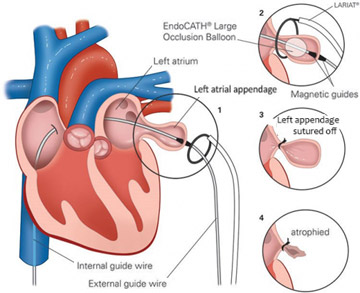New Treatment for Atrial Fibrillation Reduces Stroke Risk
More options for millions of Americans living with a potentially deadly heart rhythm disorder
STONY BROOK, NY, March 10, 2014 — Doctors at the Stony Brook Heart Institute Electrophysiology Lab are using a new nonsurgical technique called the LARIAT Suture Delivery Device to treat patients with atrial fibrillation, or A-Fib, who cannot tolerate blood thinning medication.
A-Fib is the most common heart rhythm disorder that causes the upper chambers of the heart to beat fast and erratically. An estimated 2.7 million Americans are living with the disorder, and if uncontrolled, can have serious consequences including stroke and early death. Currently the condition accounts for more than 20 percent of stroke-related deaths.
Patients are normally given blood thinners such as warfarin (Coumadin) and other anticoagulants to manage their condition by preventing blood clots. However patients must rigorously manage the level of the drugs in their blood. For most patients, these blood thinners are very effective in reducing the risk of stroke but there is a potential for bleeding which in some cases can be serious. For those individuals who cannot tolerate blood thinners due to prior bleeding or those who are at a high risk for bleeding, the LARIAT procedure can safely reduce the risk of stroke without any further bleeding risk.
The LARIAT procedure is a nonsurgical, minimally-invasive technique that uses sutures to tie off the left atrial appendage of the heart. This area of the heart is the primary source of blood clots leading to stroke in patients with atrial fibrillation.
With the patient under general anesthesia, physicians guide two catheters into the patient's heart to seal the left atrial appendage with a pre-tied suture loop--similar to a lasso--with the LARIAT device. Rather than a surgical procedure, the technique uses a needle to introduce catheters into the heart.
"In the past there weren't any alternatives that we could really offer these types of patients," said Roger Fan, MD, Associate Professor, Department of Medicine, Director of Arrhythmia Consult Service, "The LARIAT is a great alternative to the possibility of a lifetime of blood thinners which can have some serious side effects like GI bleeds, as well as an alternative to invasive open-heart surgery."
On December 3, 2013, Dr. Fan and his team at the Stony Brook Heart Institute completed their first LARIAT procedure without having to spread the ribcage or cut through bone to reach the heart.
 The left atrial appendage is a sac attached to the left upper chamber of the heart where blood clots and strokes originate from in patients with atrial fibrillation. The LARIAT procedure is a minimally invasive procedure to close the left atrial appendage to decrease the risk of stroke. 1. A magnetic wire is inserted into the heart through the groin vein, and matched to another wire from the outside of the heart, inserted from a needle stick into the chest wall. 2. The LARIAT suture is advanced across the magnetic wire connection, to the base of the left atrial appendage. 3. The suture is tied down, closing the left atrial appendage. 4. Over time, the left atrial appendage dissolves.
The left atrial appendage is a sac attached to the left upper chamber of the heart where blood clots and strokes originate from in patients with atrial fibrillation. The LARIAT procedure is a minimally invasive procedure to close the left atrial appendage to decrease the risk of stroke. 1. A magnetic wire is inserted into the heart through the groin vein, and matched to another wire from the outside of the heart, inserted from a needle stick into the chest wall. 2. The LARIAT suture is advanced across the magnetic wire connection, to the base of the left atrial appendage. 3. The suture is tied down, closing the left atrial appendage. 4. Over time, the left atrial appendage dissolves.

